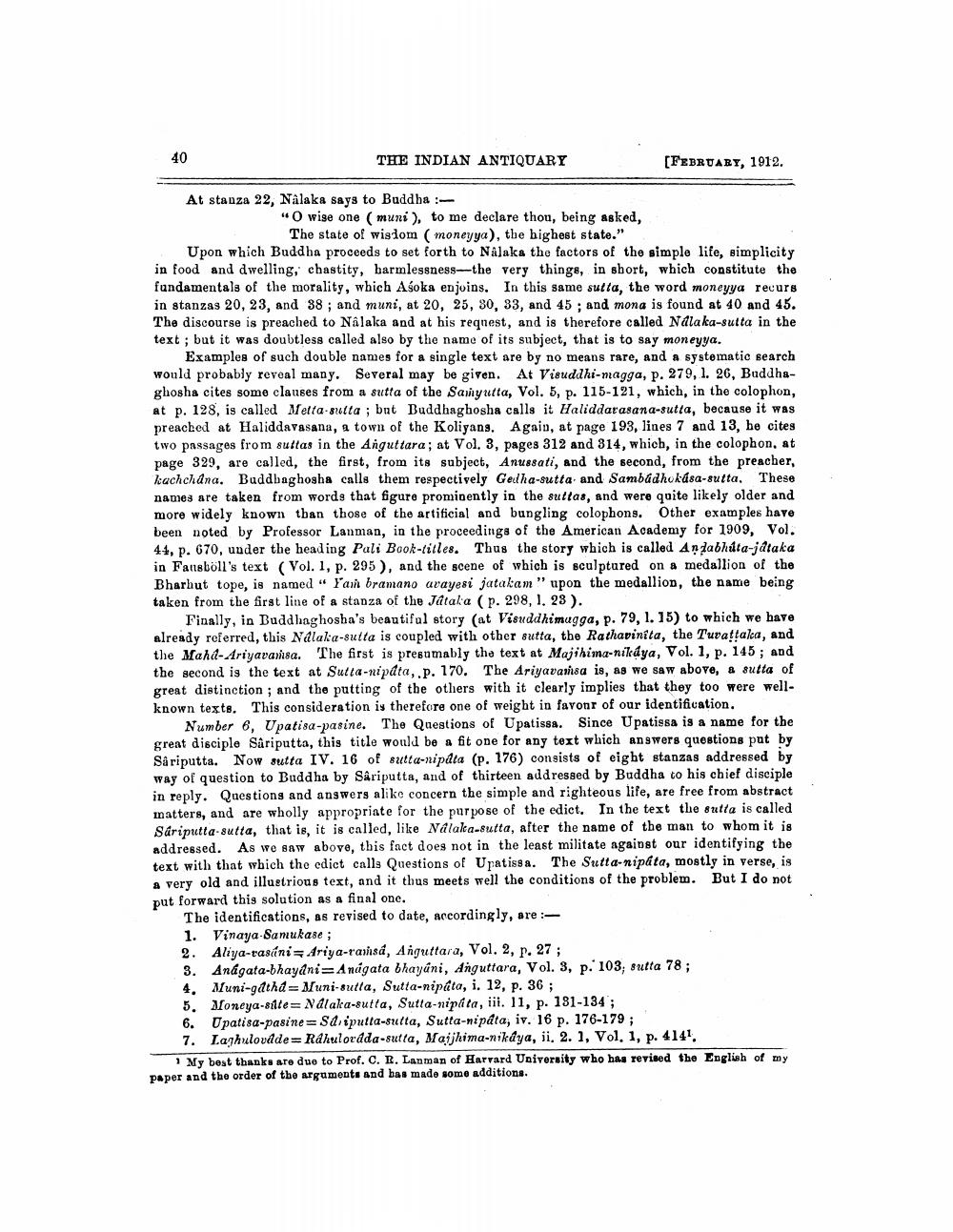________________
40
THE INDIAN ANTIQUARY
At stanza 22, Nâlaka says to Buddha :
[FEBRUARY, 1912.
"O wise one (muni), to me declare thou, being asked, The state of wisdom (moneyya), the highest state."
Upon which Buddha proceeds to set forth to Nâlaka the factors of the simple life, simplicity in food and dwelling, chastity, harmlessness-the very things, in short, which constitute the fundamentals of the morality, which Aśoka enjoins. In this same sutta, the word moneyya recurs in stanzas 20, 23, and 38; and muni, at 20, 25, 30, 33, and 45; and mona is found at 40 and 45. The discourse is preached to Nâlaka and at his request, and is therefore called Nalaka-sutta in the text; but it was doubtless called also by the name of its subject, that is to say moneyya.
Examples of such double names for a single text are by no means rare, and a systematic search would probably reveal many. Several may be given. At Visuddhi-magga, p. 279, 1. 26, Buddhaghosha cites some clauses from a sutta of the Samyutta, Vol. 5, p. 115-121, which, in the colophon, at p. 128, is called Metta-sutta; but Buddhaghosha calls it Haliddarasana-sutta, because it was preached at Haliddavasana, a town of the Koliyans. Again, at page 193, lines 7 and 13, he cites two passages from suttas in the Anguttara; at Vol. 3, pages 312 and 314, which, in the colophon, at page 329, are called, the first, from its subject, Anussati, and the second, from the preacher, kachchana. Buddhaghosha calls them respectively Gedha-sutta and Sambadhokása-sutta. These names are taken from words that figure prominently in the suttas, and were quite likely older and more widely known than those of the artificial and bungling colophons. Other examples have been noted by Professor Lanman, in the proceedings of the American Academy for 1909, Vol. 44, p. 670, under the heading Pali Book-titles. Thus the story which is called Andabhúta-jataka in Fansböll's text (Vol. 1, p. 295), and the scene of which is sculptured on a medallion of the Bharhut tope, is named " Yam bramano avayesi jatakam" upon the medallion, the name being taken from the first line of a stanza of the Jataka (p. 298, 1. 28).
Finally, in Buddhaghosha's beautiful story (at Visuddhimugga, p. 79, 1. 15) to which we have already referred, this Nalaka-sutta is coupled with other sutta, the Rathavinita, the Tuvaṭṭaka, and the Mahd-Ariyavamsa. The first is presumably the text at Majihima-nikaya, Vol. 1, p. 145; and the second is the text at Sutta-nipdta, .p. 170. The Ariyavamsa is, as we saw above, a sutta of great distinction; and the putting of the others with it clearly implies that they too were wellknown texts. This consideration is therefore one of weight in favour of our identification.
Number 6, Upatisa-pasine. The Questions of Upatissa. Since Upatissa is a name for the great disciple Sâriputta, this title would be a fit one for any text which answers questions put by Sâriputta. Now sutta IV. 16 of sutta-nipata (p. 176) consists of eight stanzas addressed by way of question to Buddha by Sâriputta, and of thirteen addressed by Buddha to his chief disciple in reply. Questions and answers alike concern the simple and righteous life, are free from abstract matters, and are wholly appropriate for the purpose of the edict. In the text the sutta is called Sariputta-sutta, that is, it is called, like Nalaka-sutta, after the name of the man to whom it is addressed. As we saw above, this fact does not in the least militate against our identifying the text with that which the edict calls Questions of Upatissa. The Sutta-nipáta, mostly in verse, is a very old and illustrious text, and it thus meets well the conditions of the problem. put forward this solution as a final one.
But I do not
The identifications, as revised to date, accordingly, are:
1. Vinaya-Samukase;
2. Aliya-vasúni Ariya-ramsá, Anguttara, Vol. 2, p. 27;
3. Anagata-bhayani Anágata bhayani, Anguttara, Vol. 3, p. 103; sutta 78;
4. Muni-gatha-Muni-sutta, Sutta-nipata, i. 12, p. 36;
5. Moneya-site= Nalaka-sutta, Sutta-nipáta, iii. 11, p. 181-134';
6. Upatisa-pasine Saiputta-sutta, Sutta-nipata, iv. 16 p. 176-179;
7. Laghulovdde-Rahulordda-sutta, Majjhima-nikdya, ii. 2. 1, Vol. 1, p. 4141.
1 My best thanks are due to Prof. C. R. Lanman of Harvard University who has revised the English of my paper and the order of the arguments and has made some additions.




